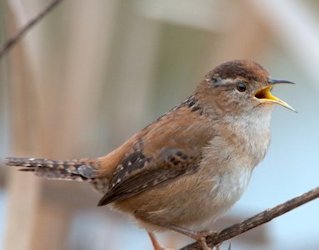
|
Nesting Behaviors of Birds Nest building requires demanding activity of birds, as well it should be. Nest provide birds with support and insulation, concealment from predators, and shelter from rain. What could be more important? Building a nest takes time, time that might be spent feeding or hiding from predators. Early during its nesting season the Great Tit devotes up to three hours each day to its nest-building efforts. The Marsh Wren spends hour after hour building courtship nest, and as soon as he finishes one, he begins to build another. Some species, however, build no nest at all, and instead lay their eggs directly on rock ledges. The nesting habits of each species have evolved over the ages and are matched to the climate, habitat, size, amount of threat by predators, clutch size, longevity, physiology, and chick development patterns. Nest can be on bare ground, in trees, in marshes, or on cliffs, and may hold from only a single egg to more than a dozen. |
||||||
|
Marsh Wren
|
|||||||
|
|||||||
| Return to Oregon Bird Choices | |||||||